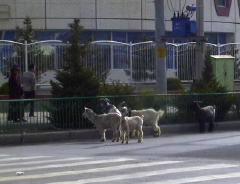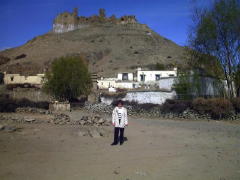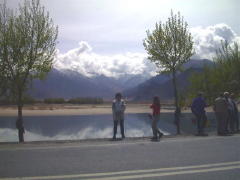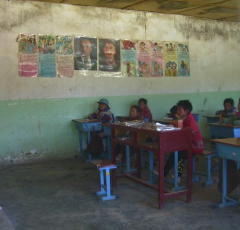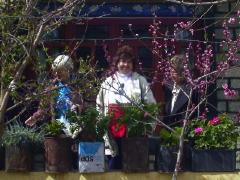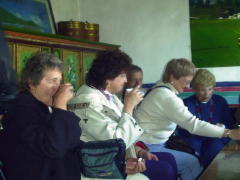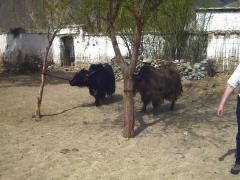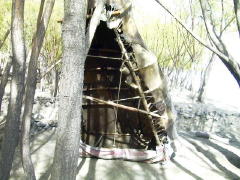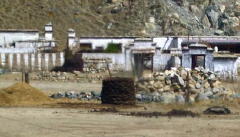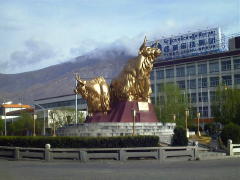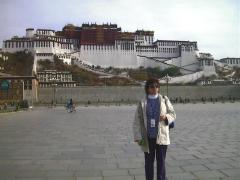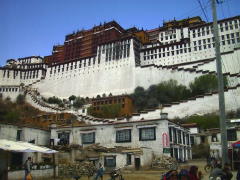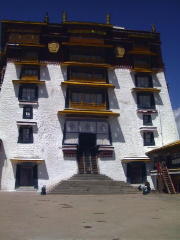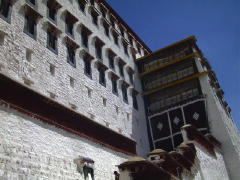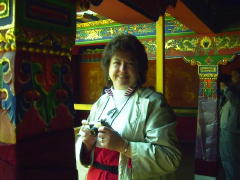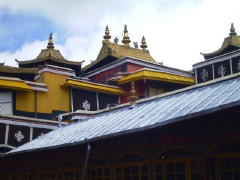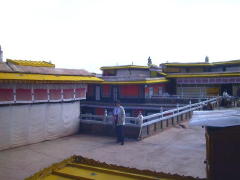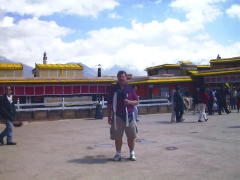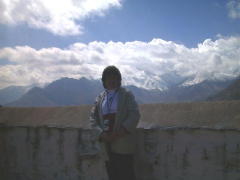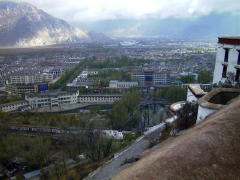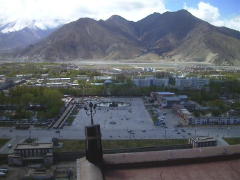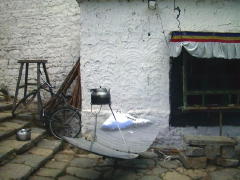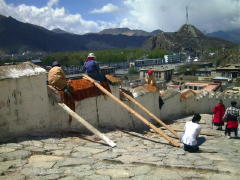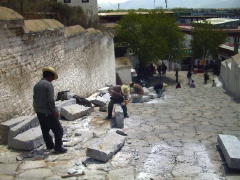|
April 21 - 23, 2000 |
Photos & Text © 2000 by Len Schwer
Revised 20 August 2000
|
(Daily Journal- Day 9) |
|
Certainly all of China is different from what Americans are used to, but I think Tibet is even different to the Chinese. The city of Lhasa was easily the most beautiful place we visited, and the most rural, but still a fairly modern city - a most strange mix. Sort of a telling picture is that of the 5 goats wondering along the main street of Lhasa eating from the roadside landscape with no one paying any attention.
The Lhasa airport is about 60 KM (40 miles) from the city (reported to be the furthest distance between a city and its airport) because Lhasa is located on a fertile river plane and it did not make sense to use valuable farm land to build an airport. You can see already that you're going to love the people of Tibet. On our bus ride to Lhasa we first stopped at a small farming village where the ruins of an old temple were located on top of a nearby hill. We stopped to enjoy and photograph the wonderful view of the mountains, and finally at an elementary school. The school visit was the most moving for me as the children were wonderful despite their grim, by our standards, school life. The school principal gave us a full tour of the school, including the open trench latrine, and through our great city guide, Chamba, answered our many questions. Most of the children stay at the school all week and walk home, a 3 hour walk, on the weekends. The children sleep in a tidy, but unheated, dormitory that has a dirt floor. The children must bring their own food to school for the week; they eat a mixture of toasted barley flour and hot water or yak tea. These children captured my heart with their smiles and laughter. The photo shown here is looking into a classroom that still displays a picture of Lenin and Stalin on the wall; I doubt you would see Stalin's picture in a Russian school? One day we made a home visit to a middle class family's house. The husband is a retired construction company manager and he and his wife live on his pension. They have two sons, one is studying journalism in Beijing and the other lives with them. The home had a nice courtyard, much like those in Beijing's Hutong, with a small vegetable garden. The wife served us cookies and yak tea - a combination of hot water and yak butter that the Tibetans seems to enjoy, but was a bit salty tasting. This was the most pleasant of the 3 home visits we made on our China tour. It just wouldn't, and couldn't, be Tibet without yaks. Our bus stopped along the road to allow us to take photographs of these two yaks. Yaks produce many useful things, in addition to the yak butter and its tea, we saw a yak skin boat too. But the most valuable yak product is yak dung, which is stored in circular piles to dry in the sun and low humidity. Since there are almost no trees, yak dung is the primary fuel for cooking and heating. It's now wonder the statue of two yaks in the central plaza of Lhasa is inscribed "The Plateau's Treasure". |
|
(Daily Journal- Day 9) |
| Our first dinner in Lhasa was a special treat, both epicurean and entertainment, at the Wild Yak Café - yep that's the real name and it's in all the guide books. First we helped our selves to a buffet of Tibetan foods that included several yak meat dishes. I thought the food was very good, closer to Indian food with curry and other spices that gave the dishes a bit of heat. After all the quests were done eating, the buffet was cleared away and a dance troupe performed several folk dances from the various regions of Tibet. The men and women dancers were quite good and change costumes for each regional dance. You can tell a married woman in traditional Tibetan dress as they wear a colorful horizontal striped apron. The dance music provided by a family of 4 that played instruments I have never seen before, but I enjoyed listening to their music. |
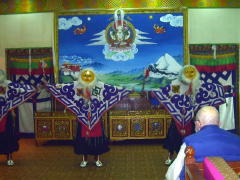 Men in traditional dress |
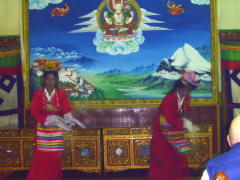 Women in traditional dress |
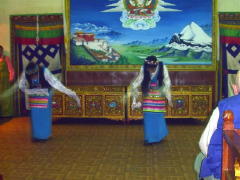 Traditional dress from another region |
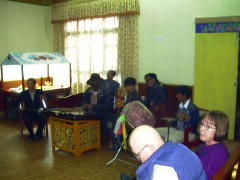 The 4 piece band |
|
(Daily Journal- Day 10) |
|
The Potala Palace is easily the most recognizable site in Lhasa and perhaps Tibet. The current Place was built in the 17th century on top of the 7th century original Palace. The Palace has two main parts, the Red Palace for religious functions and former home of the Dalai Lama, and the White Palace for affairs of government. Our bus dropped us off near the top of the Palace hill and we walked down through the Palace and met the bus at the large square in front of the Palace.
No free indoor photography was permitted, so my pictures are of, and from, the roof. The views from the roof were beautiful as we had a mostly sunny day with some large white clouds. A photographer would have shown the mountains in the background to better advantage, but I think these snapshots give you an impression of the views. On the final part of the walk down I saw one of the ubiquitous solar water heaters the Tibetans use to boil water. Since Lhasa has many sunny days, these simple devices make a lot of sense. I tested the temperature of this heater and was unimpressed, then the guide adjusted the position to catch the current sun position and heat was too intense to hold your hand near the pot. Most of the repair and maintenance work on the Palace continues year round. The monks hire the local people to do the work and everything I saw was done with hand tools. The maintenance includes an annual application of whitewash at the beginning of the Tibetan New Year. |
|
(Daily Journal- Day 10) |
|
The nearby Sera Monastery has a small temple but is primarily used for teaching monks. The students are permitted 2 hours/day to speak to each other, but in the form of a question & answer period. The young monks pair up with one standing and asking the questions and the seated monk provides the answers. In asking the question, the monk slaps his hands together, sort of as an attention getting device. If the answer is slightly wrong the hands are slapped again, but using the back of one hand into the palm of the other. If the answer is very wrong, a circular motion is made over the head of the seated monk, kind of like our hand sign for crazy?
This monastery is doing quite well and they have more young men applying than there are places available. As with most of the temples we saw in Tibet, this temple and monastery is also being refurbished using local labor. Again all the work is done with hand tools. |
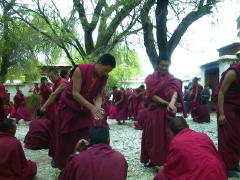 Students asking questions |
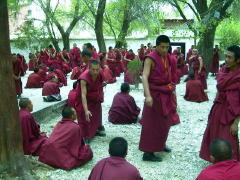 and listening to answers |
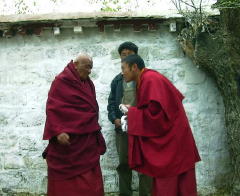 The old teacher and our guide Chamba (back) |
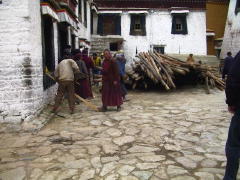 Refurbishment work |
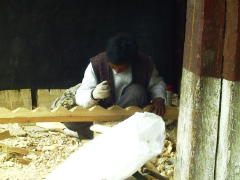 Wood craftsman with hand tools |
|
(Daily Journal- Day 11) |
| Considered the holiest temple in Tibet, Jokhang Temple is over 1300 years old and contains a Buddha statue that is thought to have been made during the lifetime of Buddha. On Sundays the inside of the temple is closed to pilgrims, but open to tourists? However, thousands of pilgrims were present turning the prayer wheels, lighting candles, and making clockwise circuits around the outside of the temple; the prayer wheels need to be turned clockwise too. Here too, indoor photography is by fee only. |
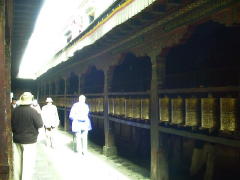 Prayer wheels |
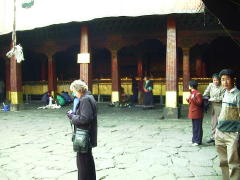 Dorothy readying camera for candle pic |
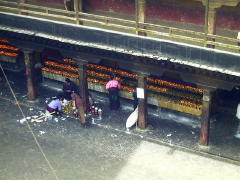 Yak butter candles lit by pilgrims |
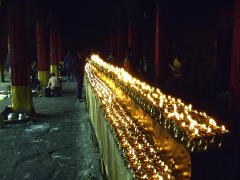 These days maragrine from Nepal is used |
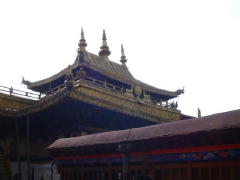 Roof top designs similar to Potala Palace |
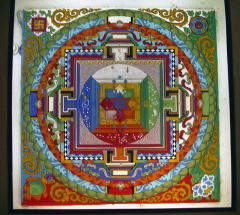 Painted ceiling on roof top |
Photos & Text © 2000 by Len Schwer
